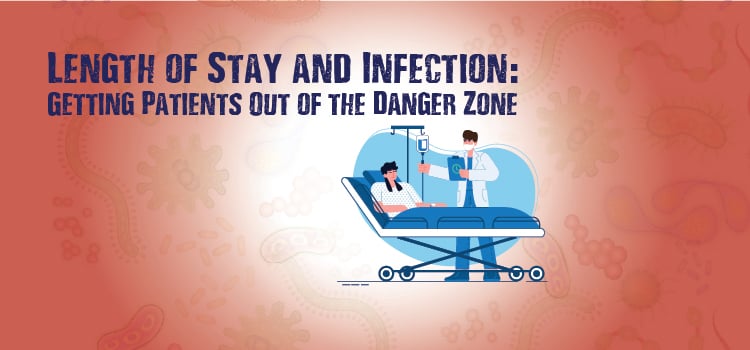Length of Stay and Infection: How To Get Patients Out of the Danger Zone

No one wants to stay in a hospital any longer than they have to. We all have an innate desire to get back to the comfort of our homes and begin the process of returning to normal activities. Some of us may not realize that there is also a very real, scientific reason for leaving the hospital as soon as possible: The longer a patient is in the hospital, the greater their chances of getting a hospital-associated infection (HAI), and once a patient has an HAI, they tend to stay longer in the hospital. It seems like a lose-lose scenario for everyone involved. It's just in everybody's best interest to reduce HAIs to not increase LOS, and shorten LOS to reduce HAIs. In today's post, we'll see how healthcare facilities are working to accomplish this dual goal.
Back in the days of fee-for-service, keeping a patient in the hospital for several days could be a financial boon for a hospital. Paid per day by Medicare/Medicaid (CMS) or third-party payors, the hospital wouldn't suffer financially if they kept a patient longer than truly necessary, especially if capacity was not an issue. With the advent of more and more elective procedures and advanced treatments - that is, more opportunities for treating chronic diseases and other ailments - hospitals faced greater pressures for beds, which then made more efficient discharges necessary.
Today, more and more hospitals are adopting the Diagnosis Related Groups (DRGs) reimbursement model, which sets a maximum length of stay. The duration of treatment is determined by the patient's diagnosis, their age, overall health status, and many other considerations. Hospitals are rewarded if they are able to treat the patient within that predetermined length of stay, and are financially penalized if they are not able to stay within that timeframe. As a result, hospitals are looking for ways to be more efficient at treating patients, keeping the the DRG length of stay, and thereby reducing the risk of infection while saving the hospital unnecessary costs.
So what are the ways that hospitals are trying to reduce unnecessary length of stay?
| Clinical Care | 1. Enhanced Recovery After Surgery (ERAS) | Protocols to reduce stress response, optimize function, and facilitate recovery |
| 2. Clinical Pathways | Determining the sequence of steps in patient care | |
| 3. Early patient mobility programs | Getting patients up and moving to reduce problems associated with extended bed rest | |
| Logistics Factors | 4. Care coordination | Patient care and information exchange shared within healthcare team |
| 5. Transition and discharge planning | Decisions leading to patient from one level of care to the next appropriate level, including discharge | |
| 6. Case management | Advocacy that oversees the treatment plans for vulnerable patients | |
| 7. Medication management | Creation and adherence to complete medication profile, including patient education | |
| 8. Specialized units for high-risk patients | Grouping vulnerable patients to enable more customized care and monitoring | |
| Human Resources | 9. Multidisciplinary rounds | Meetings in which nursing, PT, social work, pharmacy, and other specialties meet together to plan patient care |
| 10. Redesign of staffing models | Flexibility in staffing to match patient needs |
Unfortunately, no one thing on this list will consistently reduce length of stay for all patients or all hospitals. If patients acquire a hospital-associated infection while receiving care, no staffing model or care coordination or multidisciplinary team will be able to counteract the impact on length of stay. Finding a consistent way to reduce (prevent) HAIs is a critical first step to reducing unnecessary length of stay, and the only consistent way to reduce HAIs is to substantially reduce the amount of contaminated surfaces surrounding the patient. Copper and copper-infused materials, also called preventive biocidal surfaces, continuously and actively kill disease causing bacteria without the need for additional steps. The biocidal copper does not have to be applied by staff or reapplied after a spill. It works whether or not the room is occupied. It doesn't even have to be replaced for the life of the product. The safety net provided by copper and copper-infused preventive biocidal surfaces reduces HAIs, and as a result, reduces unnecessary length of stay. That sounds like a win-win scenario for everybody.
![EOScu Logo - Dark - Outlined [07182023]-01](https://blog.eoscu.com/hubfs/Eoscu_June2024/Images/EOScu%20Logo%20-%20Dark%20-%20Outlined%20%5B07182023%5D-01.svg)

![[infographic] From Contaminated Rooms to Infected Patients: A Proof in 6 Steps Download and share!](https://no-cache.hubspot.com/cta/default/216314/interactive-178434448899.png)



